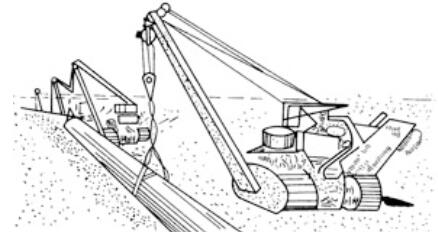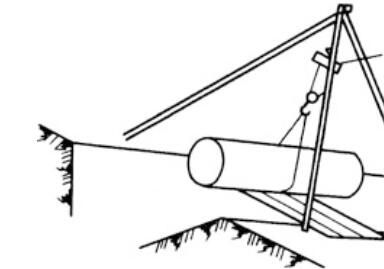Gas pipeline is generally very long, should be taken to segment flowing operation, that is, according to the construction force, reasonable arrangements, segment construction, pipe trench excavation, immediately install the pipeline, while excavating the next section of the pipe trench. Immediately after the excavation of the trench, the steel pipeline will be installed and the next section of the trench will be excavated at the same time.
Segmented construction is an effective measure to ensure project quality, reduce accidents, speed up the project schedule and reduce project cost, which requires reasonable organization of excavation, pipe assembly, welding (or twisting mouth), segmented strength test and tightness test, segmented blowing, steel pipe weld anti-corrosion package mouth, backfill, etc., to minimize the construction period.
Steel pipe transport and pipe laying should be as far as possible in the pipe trench dug into after. The steel pipe will be laid out on the other side of the trench pile of soil, the edge of the trench and the outer wall of the steel pipe between the safety distance of not less than 500mm. prohibit the first in the trench side of the pipe and then dig the trench, the soil, bricks, stones and other pressure on the tube, damage to the corrosion layer and steel pipe, so that the tube into the soil. When laying the pipe, should pay attention to the first and last connection. When laying pipes in the street, try to lay pipes by one side, do not affect the traffic, avoid vehicles and other damage to the pipeline, and try to shorten the placement time of the pipeline on the road.
Underground gas pipeline mostly steel pipe, in order to prevent corrosion of steel pipe, commonly used epoxy coal tar anticorrosion insulation layer, coal tar magnetic paint outer covering layer with petroleum asphalt anticorrosion insulation layer anticorrosion. The anti-corrosion insulation layer is generally prefabricated centrally, inspected and qualified, and then transported to the site for installation. In the process of pipeline transportation, stacking, installation and backfilling, the anti-corrosion insulation layer must be properly protected to extend the service life of gas pipelines and safe operation.
A. Transportation and pipe laying
When transporting steel pipes in the prefabricated plant, the quality certificate of the anti-corrosion insulation layer and the appearance quality should be checked. If necessary, the thickness, adhesion and insulation inspection can be carried out, and then transported after passing.
- 1. Coal tar magnetic paint outer covering anti-corrosion steel pipe coal tar magnetic paint is easy to brittle and crack at low temperature, according to the different models of coal tar touch paint, different minimum ambient temperature of transportable is specified. When the temperature is expected to be equal to or lower than the minimum ambient temperature that can be handled, it cannot be transported or handled. As the coal tar magnetic paint covering layer is thicker and easy to bruise, wider nylon belt spreader should be used. When transported by truck, the steel pipe is placed on a wide wooden support with a curved supporting surface, and the steel wire rope etc. fastening the steel pipe should be well padded; during transportation, the steel pipes cannot collide with each other. When transported by rail, all steel pipes should be carefully installed in the padded pipe bracket or bedding, all the supporting surface and shipping fence should be well padded, the pipe sections should be separated so that they do not collide with each other. Steel pipe welding with coal tar magnetic paint anti-corrosion, rolling welding is not allowed, and fixed welding is required to protect the cover layer. Therefore, after the pipe trench is dug, that is, the welding work pit is dug, the steel pipe will be lifted directly from the car to the trench, so that it is in place. When the steel pipe is stacked along the side of the pipe trench, it should be supported up and off the ground to prevent damage to the cover layer. When the bottom of the trench is rock, etc., which will damage the cover layer, a layer of sieved soil or sand should be padded at the bottom of the trench.
- 2. Epoxy coal asphalt anti-corrosion layer, petroleum asphalt coating and polyethylene adhesive tape anti-corrosion layer of steel pipe spreader should be wider nylon belt, shall not use steel wire rope or chain. Move the steel pipe with a crowbar, should be set rubber tube. When transporting by truck, steel pipe should be padded with straw bags to avoid collisions. When laying pipe along the edge of the trench, the steel pipe should be padded to prevent damage to the corrosion layer.
B. The trench edge group welding
Trench side pair welding is to weld several steel pipes on the ground next to the trench, using rolling welding, easy to ensure quality, easy to operate, high production efficiency, welded into pipe sections and then down into the trench. The length of the pipe section is determined by the size of the pipe diameter and the method of the pipe, not too long and cause difficulties in moving. It should not be too long and cause difficulty in moving. It should not be bent too much and damage the pipe and anti-corrosion layer. Each pipe section should be 30~40m long. As the coal tar magnetic paint overlay anti-corrosion steel pipe does not allow rolling welding, so each steel pipe can only be placed in the trench using fixed welding.
Steel pipe by steel pipe to remove the inner wall of soil, debris, placed on the square wood or counterparts support grouping. The main work is to align, find the center, spot welding, welding. Special attention should be paid to the spiral weld or straight weld of seamed steel pipe staggered spacing, not less than 100mm arc length. Spot welding and welding, no knocking steel pipe. Layered welding, welding to a certain extent, turning the steel pipe, welding in the best position. The first layer of welding and then welding the second layer, forbidden to weld all the half of the weld, and then rotate the steel pipe, welding the other half of the weld.
Before the pipe section under the trench, the application of EDM leak detector on the pipe section anti-corrosion layer for a comprehensive inspection, found that there are leaks in accordance with the relevant regulations immediately and carefully fill the wound, and then use the EDM leak detector to check after filling the wound, and only after passing the trench.
Before the end of the shift, use the temporary blocking plate to block both ends of the pipe section to prevent debris from entering the pipe.
C. The pipeline under the trench and installation
The method of pipeline trenching can be determined according to the diameter and type of steel pipe, the trench situation, the construction site environment and construction machinery and other circumstances. Generally speaking, a car-type or crawler crane should be used under the pipe, when the road next to the trench is narrow, more trees and poles around, the pipe diameter is small, only with manual under the pipe.
1. Down the pipe way
- (1) Concentrated pipe down pipe concentrated in the trench side somewhere down to the trench, and then in the trench will be transported to the required location. Suitable for poor soil quality and support of the trench, or underground obstacles, not easy to disperse under the pipe.
- (2) Scattered pipe steel pipe along the edge of the trench in order, in turn down to the trench. This method is mainly used to install cast iron pipes.
- (3) Combination lifting. Several steel pipes will be welded into pipe sections, and then down into the trench.
2. Before the pipe goes down the trench, the pipe trench should meet the following requirements
- (1) Before going down the trench, the pipe trench should be cleared of collapsed soil, stones, rainwater, oil and snow.
- (2) The depth, elevation and section size of the pipe trench or culvert shall be checked and shall conform to the design requirements.
- (3) Stone section pipe trench, the thickness of loose bedding shall not be less than 300mm, and the bottom of the trench shall be flat and free of stones.
3. Lowering method
(1) Crane down pipe method using tire type or crawler type crane. As shown in Figure 7-1.
Figure 7-1 Crawler crane under the pipe
When lowering the pipe, the crane moves along the trench and must use special nylon spreader. The lifting height should be 1m. After lifting the steel pipe, turn the lifting arm to make the steel pipe move to the top of the trench and then lightly put it to the bottom of the trench. The position of the crane should be kept at a certain distance from the edge of the trench, so as not to collapse the soil at the edge of the trench under too much pressure. Pipe ends tied to the rope, pulled by people, at any time to adjust the direction and prevent the steel pipe swing. Do not damage the anti-corrosion layer. Hanging pipe spacing should be in line with the requirements of Table 7-1.
Table 7-1 different pipe diameter pipe spacing
| Pipe diameter D/mm |
Allow spacing per m |
Pipe diameter D/mm |
Allow spacing per m |
| 1220 |
32 |
351 |
15 |
| 1020 |
29 |
325 |
15 |
| 920 |
27 |
299 |
14 |
| 820 |
25 |
273 |
13 |
| 720 |
23 |
245 |
12 |
| 630 |
21 |
219 |
11 |
| 529 |
19 |
168 |
9 |
| 478 |
18 |
159 |
8 |
| 426 |
17 |
114 |
6 |
| 377 |
16 |
108 |
6 |
Steel pipe outside diameter greater than or equal to 529mm pipe, under the trench, should use three pipe hoist at the same time lifting. Diameter less than 529mm pipe under the trench, the crane should not be less than 2 sets.If only two or three steel pipes are welded together, 1 pipe hoist can be used to lower the pipe.
Pipeline construction, should be as far as possible to reduce the force of the pipe. When lifting, minimize pipe bending to prevent cracking of pipe and anti-corrosion layer. The steel pipe should be properly placed in the pipe trench to prevent the steel pipe from additional stress.
The pipe should be placed in the center of the trench, and its allowable deviation should not be greater than 100mm. the pry bar or roll bar used to move the pipe should be coated with rubber hose to protect the corrosion layer from damage.
(2) Manual pipe lowering method
1) Pressure rope under the pipe method in each end of the steel pipe set 1 big rope (rope thickness selection by the weight of the steel pipe), with the help of tools control, slowly relax the rope, so that the steel pipe along the trench wall or by the trench wall position of the rolling bar slowly rolled into the trench. Cast iron pipe under the pipe more with this method. There are anti-corrosion layer steel pipe with this method, should be laid under the pipe surface smooth wooden board or rubber tube roll bar, and then rubber tube coat of the crowbar will move the steel pipe to the edge of the ditch (on the way if there is a pile of soil should be first pile of soil flattening), in the ditch wall diagonally against the roll bar, with two large rope on both sides of the pipe end 1/4 from the bottom of the pipe through the soil in the side of the pipe into the crowbar or riser, the large rope wrapped in the crowbar or riser on two or three turns, artificially pull the large rope The rope can be pried, gradually relax the rope, so that the steel pipe slowly fall into the ditch along the trench wall of the rolling bar. The bottom of the trench shall not have bricks, rocks and other hard objects, and shall not fall into the trench steel pipe. See Figure 7-2.
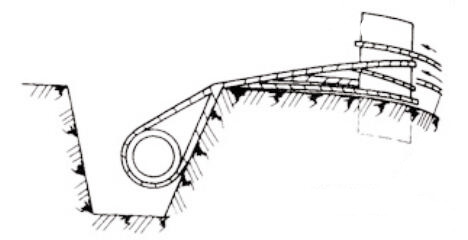
Figure 7-2 vertical pipe method pressure rope
2) Tower under the pipe method using
Installed in the tower on the compound carriage, guide chain and other equipment for the lower pipe, first roll the steel pipe on the roll bar to the rack under the diving board across the trench, and then lift the steel pipe, remove the diving board, the steel pipe down to the trench. The number of towers is determined by the pipe diameter and length of the pipe section. See Table 7-1. The spacing should not be too large to prevent damage to the steel pipe and corrosion protection layer. Figure 7-3 for the three-legged tower down tube; Figure 7-4 for the high tower down tube; Figure 7-5 for the guide chain down tube.
Fig. 7-3 Three legs tower lower pipe
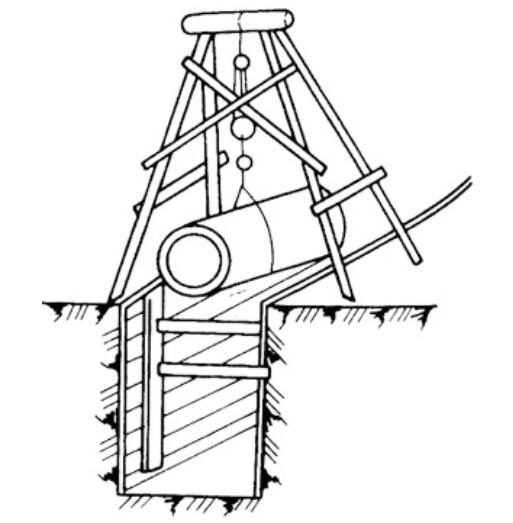
Figure 7-4 High tower down tube
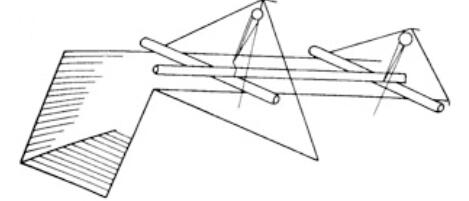
Figure 7-5 Inverted chain down tube
4. Stabilization, welding and anti-corrosion stabilization is to stabilize the steel pipe on the foundation or base according to the designed mark off and horizontal position.
The pipe should be placed in the center of the trench, and its allowable deviation should not be greater than 100mm pipe should be placed in the trench steadily, and there should be no overhang under the pipe to prevent the pipe from additional stress.
If there is any error in the position of the welding work pit dug out beforehand, it should be re-digged according to the actual need. When digging, do not damage the anti-corrosion layer of the pipe. The mud and debris inside the pipe should be removed before the steel pipe is aligned. When group welding in the trench, the gap and the wrong edge of the counterpart should meet the requirements and keep the pipe in a straight line. The mud and rust on both sides of the weld should be removed before welding.
Pipeline welding is completed, before backfilling, a comprehensive inspection must be carried out with an EDM leak detector, and the EDM breakdown should be repaired. Long-distance gas pipeline anti-corrosion insulation layer inspection should comply with the provisions of Table 7-2, the town gas pipe should comply with the provisions of the relevant standards. Do not meet the requirements of the repair and then check until qualified.
Table 7-2 anti-corrosion insulation layer of high-voltage electric spark leak detection standards
| Anti-corrosion type |
Anti-corrosion insulation class |
Test voltage /kV |
Testing standard |
| Asphalt |
ordinary |
16 ~ 18 |
No breakdown is qualified |
| To strengthen |
22 |
No breakdown is qualified |
| , strengthen |
16 |
No breakdown is qualified |
| Coal epoxy pitch |
ordinary |
> 2 |
No breakdown is qualified |
| To strengthen |
> 3 |
No breakdown is qualified |
| Adhesive tape |
- |
24 |
No breakdown is qualified |
| Epoxy powder |
0.4 mm thick |
2 |
No breakdown is qualified |
After pipeline group welding, it is necessary to carry out nondestructive flaw detection of the weld, strength and tightness test of the pipeline, and then after passing the weld mouth wrap mouth corrosion, and check with EDM before all backfilling. Usually after the welding of steel pipe, leaving the welding work pit, the first part of the body of the pipe will be filled with soil to cover the body of the pipe, so as to avoid stones and other hard objects falling on the pipe, damaging the anti-corrosion layer, and at the same time can reduce the thermal expansion and contraction of the pipe due to temperature changes so that the anti-corrosion layer and soil friction and damage.
Underground gas pipeline and buildings, structures or adjacent pipelines, cables between the horizontal and vertical clear distance, should not be less than the provisions of Table 1-6 and Table 1-7. If there are difficulties in the arrangement of terrain restrictions, and can not be solved, after consultation with the relevant departments to take effective protection measures, Table 1-6 and Table 1-7 net distance can be appropriately reduced.
When the gas pipeline encounters obstacles, the following measures are often taken.
- (1) When the actual situation is less than the net distance specified in Table 1-6 and Table 1-7, according to local conditions, the gas pipeline is bypassed horizontally or vertically and four bends are added.
- (2) Increase the casing and lay the gas pipeline in the casing.
- (3) Increase the trench and lay the gas pipe in the brick pipe trench.
